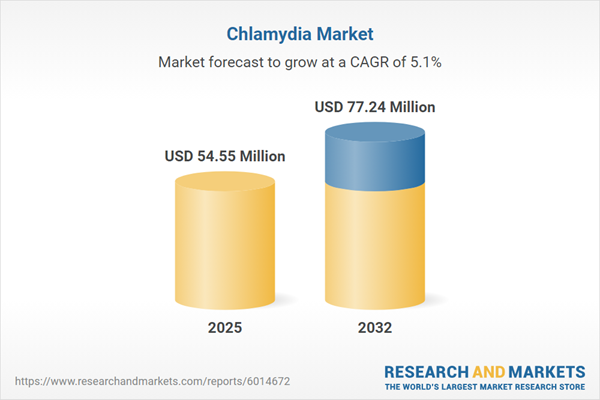Speak directly to the analyst to clarify any post sales queries you may have.
The chlamydia diagnostics market is evolving rapidly as healthcare organizations seek diagnostic technologies that support adaptable testing models, streamlined operations, and continuous regulatory compliance. Senior decision-makers are capitalizing on opportunities to enhance diagnostic capabilities, ensuring both operational agility and patient-centric care models.
Market Snapshot: Chlamydia Diagnostics Market Overview
Driven by molecular diagnostics and digital health innovation, the chlamydia diagnostics market is achieving steady expansion. Demand for accurate, accessible testing is reshaping both centralized and decentralized healthcare environments. Clinical executives now prioritize platforms that offer rapid, reliable, and adaptable diagnostic performance. Integration of next-generation technologies is accelerating, while regulatory frameworks shift to enable more flexible workflows. These changes are equipping healthcare organizations to optimize service delivery and capture new growth channels across diverse care settings.
Scope & Segmentation of the Chlamydia Diagnostics Market
- Product Types: Automated analyzers, PCR analyzers, point-of-care devices, end-point PCR systems, real-time PCR platforms, culture media, EIA reagents, NAAT reagents, strand displacement amplification platforms, transcription mediated amplification systems, home collection kits, self-collection swabs, mail-in kits, laboratory diagnostic kits, professional diagnostic kits, and rapid point-of-care kits. Each product group addresses operational variety, enabling flexible result turnaround to suit organizational needs.
- Test Methods: Enzyme immunoassay protocols, rapid EIA formats, microplate EIA, PCR-based nucleic acid amplification assays, strand displacement amplification, transcription mediated amplification, rapid immunochromatographic and lateral flow assays. These methods allow consistent precision and adaptability across laboratories and various clinical settings.
- End Users: Family planning clinics, STD specialty centers, hospital laboratories, independent diagnostic labs, inpatient and outpatient departments. Within these segments, advanced diagnostic platforms meet growing public health surveillance and support early detection to widen patient access.
- Distribution Channels: Diagnostic center pharmacies, hospital pharmacies, retail pharmacies, manufacturer-operated online platforms, third-party e-retailers, chain pharmacies, independent pharmacies. These channels enable broad patient reach and competitive vendor participation globally.
- Regions Covered: Americas (United States, Canada, Mexico, Brazil, Argentina), EMEA (United Kingdom, Germany, France, MENA), Asia-Pacific (China, India, Japan, Australia, Southeast Asia). Regional deployment strategies vary according to regulatory requirements, procurement priorities, and service delivery approaches.
- Leading Companies Profiled: F. Hoffmann-La Roche Ltd, Abbott Laboratories, Hologic, Danaher Corporation, Becton, Dickinson and Company, bioMérieux SA, Siemens Healthineers AG, QIAGEN N.V., Sekisui Chemical Co., Ltd., Luminex Corporation. These companies drive innovation and set industry benchmarks for diagnostic solutions.
Key Takeaways & Strategic Insights
- Self-collection kits and digital platforms are closing diagnostic access gaps, increasing patient involvement, and promoting decentralized and patient-centered testing approaches.
- Regulatory flexibility is accelerating adoption of new diagnostic technologies, allowing healthcare providers of all sizes to respond efficiently to innovation cycles.
- Adoption of modular diagnostic systems enables operational agility, supporting both institutional and direct-to-patient models as care environments and testing volumes change.
- The synergy between digital informatics and telemedicine is streamlining workflows and enabling prompt, data-driven decision-making with positive impacts on population health monitoring.
- Strategic partnerships, alliances, and mergers are expanding the diversity of diagnostic offerings, fostering broader market alignment and integrated regional coverage.
Tariff Impact: Supply Chain & Procurement Strategies
Shifts in U.S. tariff policy have increased import costs for chlamydia diagnostic products. In response, healthcare organizations are diversifying suppliers, expanding domestic manufacturing, and pursuing volume-based procurement to address trade volatility. Hospitals and laboratories are strengthening collaborations and optimizing inventory management to sustain continuous diagnostic availability in the face of supply chain challenges.
Methodology & Data Sources
This chlamydia diagnostics market analysis is based on consultations with healthcare professionals, industry experts, systematic reviews of scientific literature, regulatory documentation, and corporate disclosures. The approach ensures findings reflect industry-wide realities and align with established best practices in diagnostics procurement and deployment.
Why This Report Matters for Senior Decision-Makers
- Delivers clear segmentation and targeted executive analysis to shape diagnostic testing strategies and inform long-term business planning.
- Enables informed decisions on technology adoption, partnership formation, and international expansion through concise coverage of trends, regulations, and market structure.
- Provides actionable insight into procurement and supply chain adaptation, supporting resilience in a dynamic global chlamydia diagnostics landscape.
Conclusion
Strategic alignment in technology, regulatory adaptation, and procurement is essential for maintaining strong diagnostic access and securing an advantageous market position in the evolving chlamydia diagnostics sector.
Additional Product Information:
- Purchase of this report includes 1 year online access with quarterly updates.
- This report can be updated on request. Please contact our Customer Experience team using the Ask a Question widget on our website.
Table of Contents
3. Executive Summary
4. Market Overview
7. Cumulative Impact of Artificial Intelligence 2025
Companies Mentioned
The companies profiled in this Chlamydia market report include:- F. Hoffmann-La Roche Ltd
- Abbott Laboratories
- Hologic, Inc.
- Danaher Corporation
- Becton, Dickinson and Company
- bioMérieux SA
- Siemens Healthineers AG
- QIAGEN N.V.
- Sekisui Chemical Co., Ltd.
- Luminex Corporation
Table Information
| Report Attribute | Details |
|---|---|
| No. of Pages | 193 |
| Published | November 2025 |
| Forecast Period | 2025 - 2032 |
| Estimated Market Value ( USD | $ 54.55 Million |
| Forecasted Market Value ( USD | $ 77.24 Million |
| Compound Annual Growth Rate | 5.0% |
| Regions Covered | Global |
| No. of Companies Mentioned | 11 |









